Republican Party is one of the two principal political parties of the United States. The other is the Democratic Party. The Republican Party is often called the G.O.P., which stands for Grand Old Party, a nickname Republicans gave their party in the 1880’s. The Republican Party has greatly influenced the nation’s history and politics.
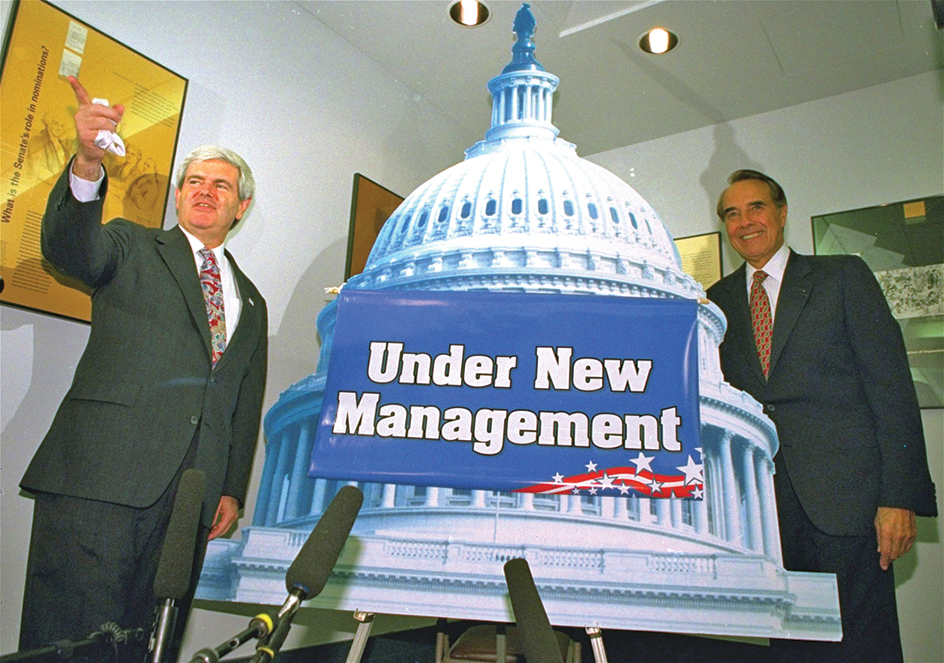
The policies of the Republican Party, like those of other political parties, have changed through the years. At first, Republican candidates received most of their support from people who opposed slavery. To gain wider support, the party passed land legislation that appealed to farmers. Republicans won the backing of business leaders by endorsing sound money policies and high tariffs. By the late 1800’s, the party represented a firm alliance of the agricultural West and the industrial East.
The Republican Party dominated politics in the United States in the 1920’s. The economy boomed during much of the decade, and the party became known as the “party of prosperity.” However, the Republicans fell out of power in the 1930’s, when the Great Depression, a worldwide economic downturn, hit the nation.
The Republican Party includes members who are strongly conservative (favoring traditional values and ideas), as well as less-conservative members called moderates. During the 1950’s, the party prospered under the moderate leader Dwight D. Eisenhower, who won presidential elections in 1952 and 1956. He was the first Republican to win two terms as president since William McKinley in 1896 and 1900. The conservatives of the Republican Party gained strength during the 1980’s under the leadership of Ronald Reagan and during the early 2000’s under George W. Bush. Both Reagan and Bush won two terms as president.
This article describes chiefly the history of the Republican Party. For information about the party’s national convention and organization, see Political convention and Political party.
Origin
of the Republican Party dates back to the strong opposition to the Kansas-Nebraska Bill of 1854. The bill permitted slavery in the new territories of Kansas and Nebraska if the people there voted for it.
The Republican Party grew out of a series of antislavery meetings held throughout the North to protest the Kansas-Nebraska Bill. One such meeting was held by Alvan E. Bovay, a leading Whig, on Feb. 28, 1854, in Ripon, Wisconsin. This meeting passed a resolution declaring that a new party—the Republican Party—would be organized if Congress passed the Kansas-Nebraska Bill.
Bovay held a second meeting in Ripon on March 20, after the Senate had approved the bill. The 53 men at this meeting appointed a committee to form the new party. Congress passed the Kansas-Nebraska Act on May 30. On July 6, at a party meeting in Jackson, Michigan, the delegates formally adopted the name Republican.
The new party had chiefly sectional appeal. Few Southern voters supported the Republicans because almost all Southerners wanted to expand slavery, not restrict it. Many Northerners supported the party. But some feared that the extreme antislavery views of such Republican leaders as Senator Charles Sumner of Massachusetts threatened the Union.
The election of 1856.
The Republicans chose John Charles Frémont, a dashing young explorer and soldier, as their first presidential candidate. During the campaign, antislavery and proslavery groups fought in Kansas. The chief campaign issue became “bleeding Kansas.” Democrats predicted that the South would secede from the Union if the antislavery Frémont won.
The voting reflected the sectional appeal of the Democratic and Republican parties. Frémont won 11 Northern states. His Democratic opponent, James Buchanan, carried 19 states—including every Southern state except Maryland—and won.
Changes in party policy.
After the Republican defeat in 1856, party leaders realized that they could not win the presidency on just the slavery issue. To broaden their appeal, Republicans endorsed construction of a transcontinental railroad system and federal aid to improve harbors and rivers. They also promised to open Western land for settlement, to raise U.S. tariff rates, and to permit slavery where it already existed.
In 1860, the Republicans chose Abraham Lincoln, a lanky, self-educated Illinois lawyer, as their presidential candidate. Lincoln had received national attention by expressing moderate antislavery views in his debates with Illinois Senator Stephen A. Douglas, a Democrat.
Lincoln easily won the election, even though he received less than 40 percent of the popular vote. The Democrats had split over the slavery issue. Northern Democrats nominated Douglas, and Southern Democrats chose Vice President John C. Breckinridge.
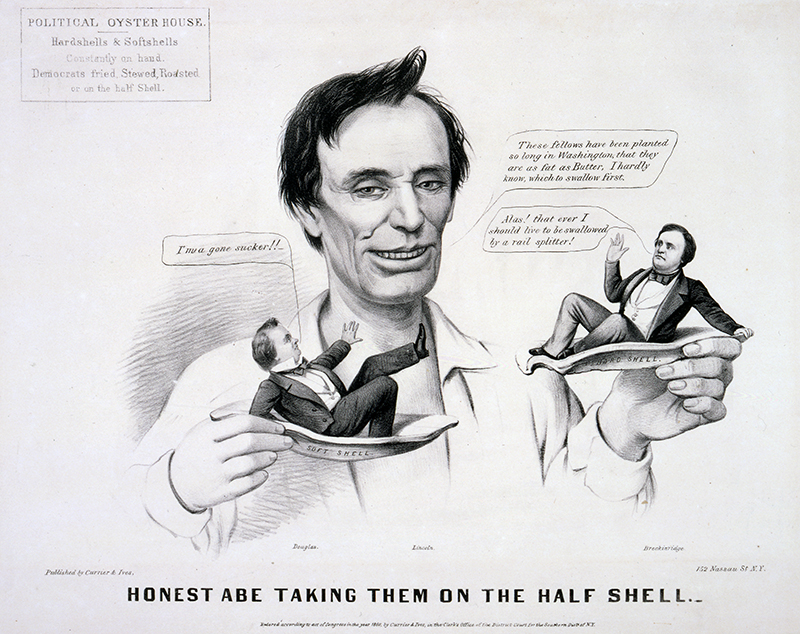
The American Civil War
began in April 1861. Most Southerners believed the election of Lincoln justified secession. In 1860 and 1861—both before and after the shooting started—11 Southern states left the Union and formed the Confederate States of America.
Above all, Lincoln wanted to save the Union. But many Republicans—the so-called Radical Republicans—made the abolition of slavery their main goal. Many Northern Democrats supported Lincoln and the war and were called War Democrats.
Lincoln tried to bring all groups of both parties together, but he succeeded only partly. By 1864, Lincoln’s chances of reelection looked doubtful. To stress the national character of the war—and to gain more supporters—the Republican Party used the name Union Party in the 1864 election. It nominated Andrew Johnson, a War Democrat, for vice president. With the help of Northern military victories just before the election, Lincoln won a second term.
On April 9, 1865, shortly after Lincoln’s second term began, Confederate General Robert E. Lee surrendered to General Ulysses S. Grant. Five days later, Lincoln was assassinated.
Loading the player...Abraham Lincoln
The Radical Republicans and Reconstruction.
Johnson hoped to follow Lincoln’s moderate plan of Reconstruction. But the Radical Republicans in Congress favored harsh punishment for the South.
The Radicals dominated Congress after the congressional elections of 1866. They divided the South into five military districts, deprived former Confederate soldiers of the vote, and gave the vote to former slaves.
The dispute over Reconstruction hardened political loyalties along sectional lines. Most Northern Republicans supported the Radical Republicans who, by 1868, felt strong enough to drop the Union Party label. Many Northern Democrats also backed Republican policies. Southerners, however, rejected Republican leadership. As a result, Reconstruction led to the birth of the Democratic “Solid South.” The Democrats dominated elections at all levels in the region. See Reconstruction.
The Republicans nominated Grant, the great Union war hero, for president in 1868, and he won an easy victory. Grant won reelection in 1872, but by this time many voters had become alarmed over corruption in both business and government. A depression in 1873 helped the Democrats win a sweeping victory in the congressional elections of the next year.
In 1876, the Republicans nominated a cautious reformer, Rutherford B. Hayes. A group of conservative Republicans called Stalwarts opposed Hayes because he favored civil service reform and friendly relations with the South. Hayes and his followers became known as Half-Breeds. Samuel J. Tilden, the Democratic candidate, won more popular votes than Hayes, but the electoral vote was disputed. A special commission declared Hayes the winner by one vote. The Democrats accepted the verdict only because the Republicans had promised to end Reconstruction and withdraw federal troops from the South. Hayes kept the promise.
Political inactivity
marked the 1880’s and 1890’s. Both major parties failed to face the problems resulting from the rapid industrialization that followed the Civil War. Many industrial monopolies set high prices for their products and services. Economic power became centered with a few wealthy business leaders, and farmers and wage earners suffered increasingly hard times.
In 1880, Republican James A. Garfield won the presidency. He was assassinated in 1881, only a few months after taking office, and Vice President Chester A. Arthur, a Stalwart, succeeded him. Arthur surprised his fellow Stalwarts by supporting civil service reform. In 1883, Congress passed the Pendleton Act, which established the merit system in the civil service.
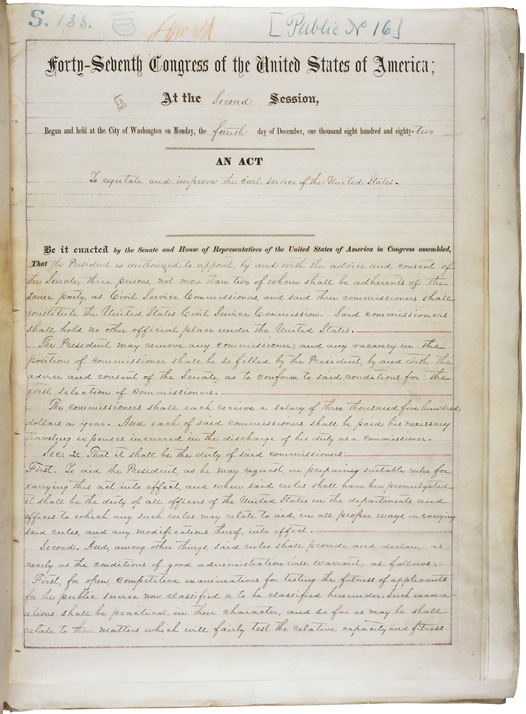
In 1884, the Republican presidential candidate, James G. Blaine, narrowly lost to Grover Cleveland. The party made the protective tariff its chief campaign issue in 1888 and won the presidency with Benjamin Harrison. In 1890, the McKinley Tariff pushed tariffs higher than they had ever been before. Dissatisfaction with the tariff helped Cleveland defeat Harrison in 1892.
The money issue
dominated the election of 1896. A third party, the Populist Party, had appeared during the early 1890’s. The Populists demanded that the government increase the amount of money in circulation by permitting unlimited coinage of silver. They believed such action would help farmers and wage earners and improve the nation’s economy. Many Democrats joined the Populists in their demand for silver coinage. In 1896, the Democrats nominated William Jennings Bryan, the leading silver spokesman, for president. The Republican candidate, William McKinley, supported a currency backed by gold. McKinley won the election.
Economic conditions improved rapidly during the late 1890’s. The U.S. victory in the Spanish-American War also gained support for the Republicans. McKinley defeated Bryan again in 1900. Six months into his second term, however, McKinley was assassinated. Vice President Theodore Roosevelt succeeded him.
The party splits.
“Teddy” Roosevelt supported much reform legislation. He brought suits against several large monopolies and crusaded for honesty in government. Roosevelt also sponsored a conservation policy, laws to protect the American public from impure food and drugs, and legislation to regulate railroad rates.
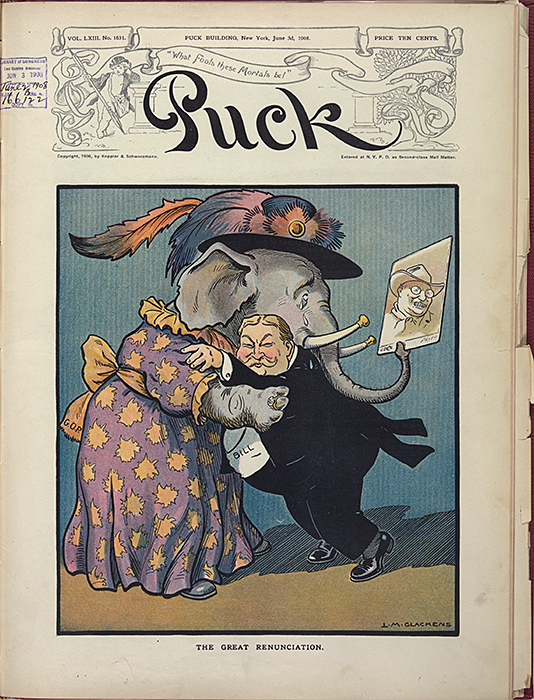
In 1908, Roosevelt chose Secretary of War William Howard Taft to succeed him and continue his policies. Taft easily beat Bryan, who ran for the third time as the Democratic nominee.
Taft brought many more suits against monopolies than Roosevelt had. But Taft, by nature quieter and more conservative than Roosevelt, lost favor with Republican progressives. He faced open hostility from the progressives after signing into law the high Payne-Aldrich Tariff in 1909. By 1912, Taft no longer led a united party, and the progressives turned to Roosevelt, who wanted to be president again. After the Republicans renominated Taft, Roosevelt left the party and formed the Progressive, or “Bull Moose,” Party. The Republican split helped Woodrow Wilson, the Democratic candidate, win the election.
The Republicans began to reunite after their defeat, and in 1916, most of them supported the party candidate, Charles Evans Hughes. But some backed Wilson because he had promoted progressive legislation and had kept the nation out of World War I, which had begun in 1914. Wilson won reelection by a close margin. A month after he took office for the second time, the United States went to war against Germany.
By the congressional elections of 1918, the Republicans had reunited, and they gained control of Congress. After the war, the Republican-controlled Senate rejected American membership in the League of Nations (see League of Nations).
During the Roaring Twenties,
the Republicans won every presidential and congressional election. Democrats showed strength only in the South. In 1920, the party’s candidate, Warren G. Harding, promised a return to “normalcy.” Americans, weary of wartime controls and world problems, wanted just that—and Harding won in a landslide.
The nation’s economy boomed during the 1920’s as business and industry expanded. Successive Republican administrations helped big business by keeping government spending and taxes low and by raising tariffs.
After Harding’s death in 1923, congressional investigations revealed corruption in several government departments during his administration. But the exposures did not prevent Harding’s successor, Vice President Calvin Coolidge, from easily winning the 1924 election. Coolidge’s conservative administration seemed to reflect the largely antiforeign, anti-immigration, antilabor mood of the nation.
In 1928, the Republicans turned to Herbert Hoover, Coolidge’s secretary of commerce. Hoover easily defeated his Democratic opponent, Alfred E. Smith, but Smith carried most of the largest cities.
Soon after Hoover took office in 1929, the worst stock-market crash in the nation’s history occurred. The Great Depression followed. Hoover tried to stop the Depression but could not do so, and he lost badly in 1932 to the Democratic candidate, Franklin D. Roosevelt. Hoover’s defeat reduced the Republican Party to a hard core of business leaders, Midwestern farmers, and conservative workers.
After the Great Depression,
the Republican Party remained the minority party for a generation. Roosevelt led the nation through the economic crisis with a massive federal program called the New Deal (see New Deal). The Republicans, far outnumbered in both houses of Congress, took little action against his policies. The 1936 Republican Party platform criticized the New Deal, but Roosevelt won reelection by a landslide over Alfred M. Landon.
By the election of 1940, World War II (1939-1945) had started. The Republicans nominated Wendell L. Willkie and continued to attack the New Deal, but Roosevelt easily won a third term. The United States entered the war in 1941. Roosevelt defeated Thomas E. Dewey in 1944 and became the only candidate to be elected president four times.
In the 1930’s and 1940’s, many Republicans accepted the idea of federal welfare programs and of U.S. leadership in world affairs. They also accepted U.S. membership in the United Nations, formed in 1945. Vice President Harry S. Truman became president after Roosevelt’s death in 1945. The Republicans expected to win the 1948 election easily, and they nominated Dewey again. But Truman won a surprise victory.
The Eisenhower years.
Dwight D. Eisenhower, a U.S. Army general and World War II hero, sought the Republican nomination for the 1952 election. He ran partly to prevent Ohio Senator Robert A. Taft, a conservative isolationist, from becoming the nominee. Eisenhower gained the nomination and easily won the general election, defeating Adlai E. Stevenson. Eisenhower carried four Southern states and broke the Democratic Solid South for the first time in over 20 years. Voters turned to Eisenhower for a variety of reasons. Many voted Republican because of dissatisfaction with the government’s conduct of the Korean War (1950-1953). Others believed charges that the Democrats had harbored Communists in high government posts. Eisenhower won reelection in 1956 by a landslide, again over Stevenson.
Loading the player...Dwight Eisenhower
Eisenhower, a moderate, won support from his own party and from many Southern Democrats. During his presidency, Congress extended Social Security benefits and passed the first civil rights act since Reconstruction. Despite his popularity, however, Eisenhower failed to make the Republican Party the country’s majority party.
Defeat, then victory.
Vice President Richard M. Nixon won the Republican presidential nomination in 1960, but he narrowly lost the election to his Democratic opponent, John F. Kennedy. After Kennedy’s assassination in 1963, Vice President Lyndon B. Johnson succeeded to the presidency.
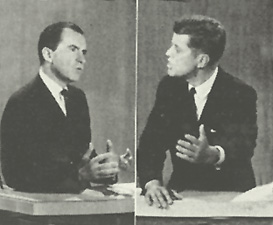
In 1964, the Republicans nominated Barry M. Goldwater, who stood for an extreme form of conservatism. Johnson defeated him overwhelmingly.
At Johnson’s urging, Congress passed additional civil rights legislation and other laws to help disadvantaged Americans. Conservative Republicans and conservative Southern Democrats joined forces to oppose many of Johnson’s programs.
For the 1968 presidential election, the Republicans turned to Nixon again. The Democrats nominated Vice President Hubert H. Humphrey. A third party, the American Independent Party, nominated George C. Wallace, a Southern Democrat who strongly opposed civil rights legislation. Nixon won even though he received only about 43 percent of the popular vote. He triumphed partly because of his “Southern strategy,” in which he appealed to conservative white Southerners. Nixon emphasized patriotism and law and order. He favored slower school integration than liberals did. His approach enabled him to win such Southern states as Florida, South Carolina, Tennessee, and Virginia.
In 1972, the Republicans renominated Nixon, and the Democrats nominated George S. McGovern. Nixon received over 17 3/4 million more popular votes than McGovern—the widest margin of any presidential election in U.S. history.
The Watergate scandal.
In 1973, Nixon helped end U.S. involvement in the Vietnam War. His administration suffered a loss of public confidence later that year, however, because of the Watergate scandal and an unrelated criminal investigation that led to the resignation of Vice President Spiro T. Agnew (see Watergate ; Agnew, Spiro T.).
The Agnew and Watergate scandals damaged the Republican Party. By the mid-1970’s, less than one-fourth of American voters called themselves Republicans. In 1976, the Republicans suffered a split within their party, as Ronald Reagan, a conservative who had served as governor of California, challenged the more moderate Ford for the presidential nomination. Ford won the nomination but lost to Jimmy Carter, the Democratic candidate, in the general election.
Loading the player...Richard Nixon announces his resignation
Victories in the 1980’s.
The Republicans won every presidential election in the 1980’s. The party, strengthened by social conservatives who opposed abortion and supported school prayer, solidified the gains Nixon had made in the South. The party also continued to appeal to economic conservatives by supporting tax cuts and a balanced federal budget.
In 1980, Republicans chose Ronald Reagan as their presidential candidate. The Democrats renominated Carter, and Representative John B. Anderson of Illinois ran as an independent. Reagan won by a wide margin. The Republicans also won control of the Senate.
In the 1984 presidential election, Reagan defeated his Democratic opponent, Walter F. Mondale. In the 1986 elections, the Democrats regained control of the Senate. In 1988, Vice President George H. W. Bush won the Republican presidential nomination. He went on to defeat his Democratic opponent, Michael S. Dukakis.
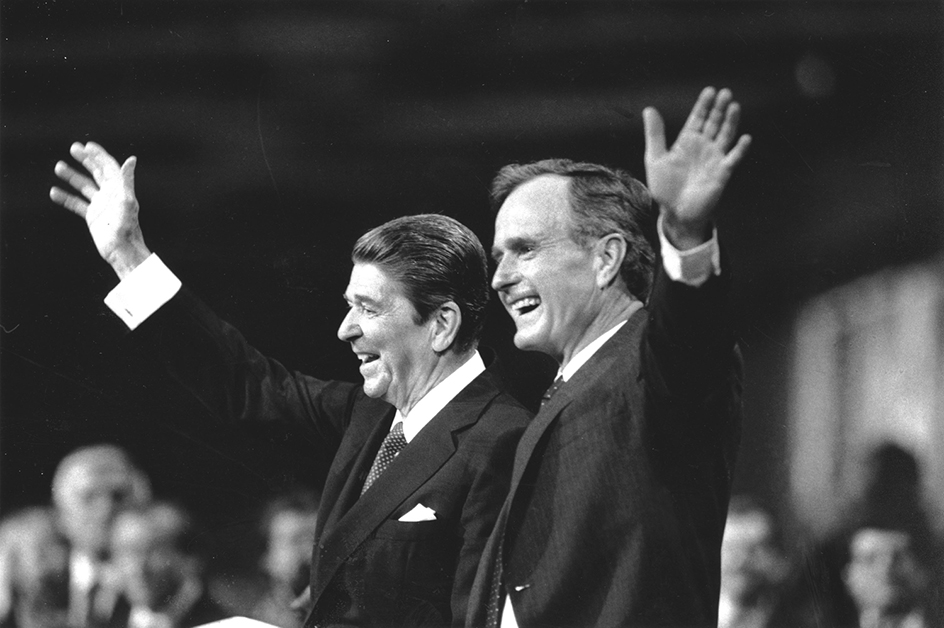
Control of Congress.
In 1992, the Republicans renominated Bush for president. The Democrats nominated Arkansas Governor Bill Clinton, and Texas businessman Ross Perot ran as an independent. Bush and Perot lost the election to Clinton.
In 1994, the Republicans won control of both houses of Congress. The party had not controlled both houses since 1955. In 1996, Senator Robert Dole of Kansas, the Republican nominee, lost the presidential election to Clinton. However, the Republicans retained control of both houses of Congress in 1996 and 1998.
The early 2000’s.
During the 2000 presidential primaries, divisions between moderate and conservative Republicans gained widespread attention. Arizona Senator John McCain, a moderate and Vietnam War veteran, ran against Texas Governor George W. Bush, son of former President George H. W. Bush. Bush considered social conservatives his base of political support, especially in the South. He won the nomination and defeated the Democratic candidate, Vice President Al Gore, in a close election. The Republicans kept control of the House, but the election left the Senate with 50 Republican members and 50 Democrats
In 2001, the Republicans lost a Senate seat when Vermont Senator James Jeffords left the party and became an independent. As a result, the Democrats gained control of the Senate. The 2002 elections shifted control back to the Republican Party. The Republicans also kept control of the House.
Bush was reelected in 2004, defeating Democratic Senator John F. Kerry of Massachusetts. During Bush’s second term, however, the Republicans suffered from congressional scandals and from criticism over the administration’s handling of the Iraq War (2003-2011). In 2006, the Republicans lost control of both houses of Congress to the Democrats.
In the 2008 election, Democratic Senator Barack Obama of Illinois defeated John McCain, the Republican nominee. Obama became the nation’s first African American to be elected president. An economic crisis that struck in the months before the election contributed to the Republican defeat. In 2009, the “tea party” movement, a loose collection of conservative activist groups, started holding rallies to oppose Obama’s policies. In 2010, voter frustration with a sluggish economy contributed to a Republican takeover of the House and a number of governorships. In 2012, Obama defeated his Republican opponent, former Massachusetts Governor Mitt Romney, to win reelection. In the 2014 elections, Republicans won a majority in the Senate, taking control of both houses of Congress.
In 2016, New York businessman Donald J. Trump won the Republican presidential nomination. He defeated Democrat Hillary Rodham Clinton, a former first lady, senator, and U.S. secretary of state, in the general election. In 2018, Democrats sought to make the elections a referendum on Trump’s policies. Republican candidates lost control of the House but retained power in the Senate. In 2020, Joe Biden, who had served as Obama’s vice president, defeated Trump in the presidential election. Democrats kept control of the House and gained a 50-50 tie in the Senate. Vice President Kamala Harris, able to cast a tie-breaking vote, gave Democrats a functional majority in the chamber. The Democrats kept their functional majority in the Senate after the 2022 elections. Republicans narrowly captured the House.
